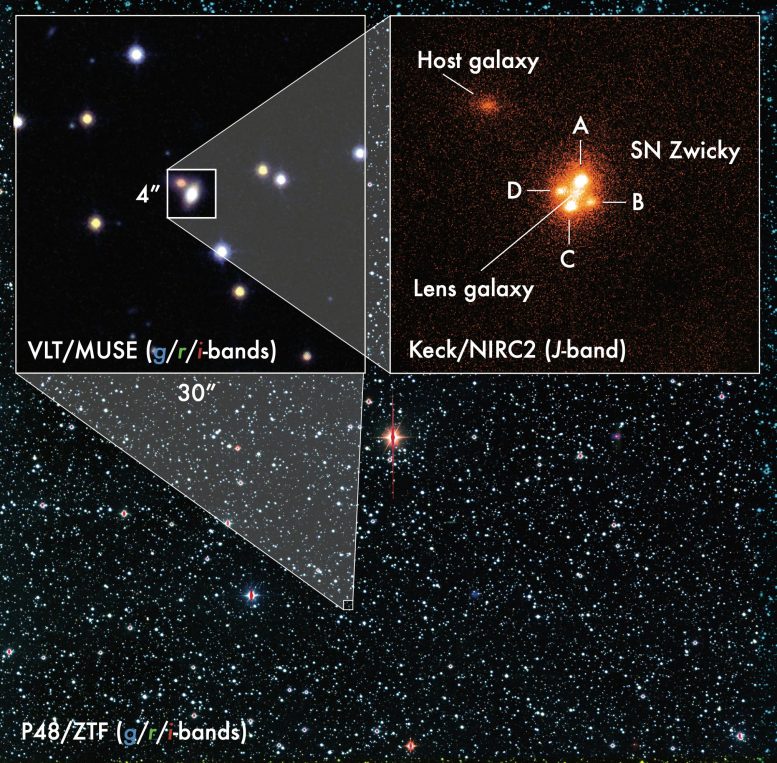
Zooming in to supernova Zwicky: starting from a small portion of the Palomar ZTF camera, one out of 64 “quadrants”, each one containing tens of thousands of stars and galaxies, the zoom-in takes us to detailed explorations carried out with the larger and sharper VLT and Keck telescopes in Chile and Hawai’i respectively. On the best resolved Keck images, the four nearly identical “copies” of supernova Zwicky can be seen. The multiple images arise due to the warping of space caused by a foreground galaxy, also seen in the center and approximately halfway between the site of the supernova explosion and Earth. Credit: J. Johansson
Physicists and astronomers have discovered a multiply-imaged lensed Type Ia supernova, “SN Zwicky,” enabling unprecedented study of galaxy properties, gravitational lensing phenomena, dark matter, and the universe’s expansion.
A team of physicists and astronomers led by researchers from the Oskar Klein Centre at Stockholm University has made an intriguing breakthrough in our ability to explore how galaxies warp the surrounding space with the discovery of a multiply-imaged lensed Type Ia supernova, dubbed “SN Zwicky.” The results are published in Nature Astronomy.
Led by Ariel Goobar from the Oskar Klein Centre at Stockholm University, the team discovered an unusual Type Ia supernova, SN Zwicky. Type Ia supernovae play a crucial role in measuring cosmic distances. They were used for the discovery of the accelerated expansion of the universe, leading to the 2011 Nobel Prize in physics. The newly discovered supernova stands out due to its extraordinary brightness and configuration of multiple images, a rare phenomenon predicted by Albert Einstein’s theory of general relativity.
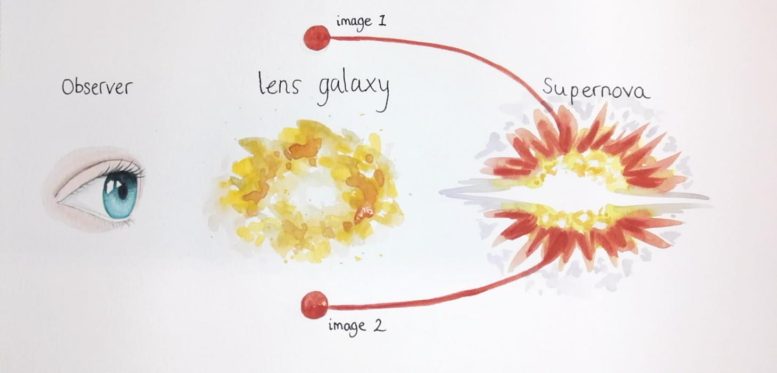
Under extraordinary circumstances, large astronomical bodies act as cosmic magnifying glasses. These magnifying glasses also create multiple light paths visible at different positions in the sky. Credit: Nikki Arendse
Within weeks of detecting the supernova at the Zwicky Transient Facility at Palomar Observatory, the team observed SN Zwicky with the adaptive optics instruments on the W. M. Keck Observatory atop Maunakea, Hawaiʻi, and the Very Large Telescopes in Chile. The Keck Observatory observations resolved the multiple images, confirming the strong lensing hypothesis behind the unusual supernova brightness. The four images of SN Zwicky were also observed with NASA’s Hubble Space Telescope.
Large astronomical bodies act as cosmic magnifying glasses
The multiply-imaged lensing effect observed in SN Zwicky is the result of the gravitational field exerted by a foreground galaxy acting as a gravitational lens. Under extraordinary circumstances, large astronomical bodies act as cosmic magnifying glasses. These magnifying glasses also create multiple light paths visible at different positions in the sky. Observing the multiple images not only reveals details about the strongly lensed supernova, it also offers a unique opportunity to explore the properties of the foreground galaxy that causes the deflection of light. This could teach astronomers more about the inner cores of galaxies and dark matter. Lensed supernovae are also very promising tools to refine models describing the expansion of the universe.
Objects with large masses such as galaxies or clusters of galaxies warp the spacetime surrounding them in such a way that they can create multiple images of background objects. This effect is called strong gravitational lensing. Credit: ESA/Hubble, NASA
New avenues for investigating gravitational lensing
As scientists continue to unravel the complexities of the universe, the discovery of SN Zwicky’s multiply-imaged lensing presents new avenues for investigating gravitational lensing phenomena and their implications for cosmology. This is an important step towards unlocking the mysteries of dark matter, dark energy, and the ultimate fate of our cosmos. “The extreme magnification of SN Zwicky gives us an unprecedented chance to study the properties of distant Type Ia supernova explosions, which we need when we use them to explore the nature of dark energy,“ says Joel Johansson, a postdoctoral fellow at Stockholm University and a co-author on the study.
Zooming in to supernova Zwicky: starting from a small portion of the Palomar ZTF camera, one out of 64 “quadrants”, each one containing tens of thousands of stars and galaxies, the zoom in takes us to detailed explorations carried out with the larger and sharper VLT and Keck telescopes in Chile and Hawai’i respectively. On the best resolved Keck images, the four nearly identical “copies” of supernova Zwicky can be seen. The multiple images arise due to the warping of space caused by a foreground galaxy, also seen in the center and approximately half-way between the site of the supernova explosion and Earth.” Credit: J. Johansson
Professor Ariel Goobar, the project’s principal investigator and the director of the Oskar Klein Centre at Stockholm University, expressed his enthusiasm for this significant finding: “The discovery of SN Zwicky not only showcases the remarkable capabilities of modern astronomical instruments but also represents a significant step forward in our quest to understand the fundamental forces shaping our universe.”
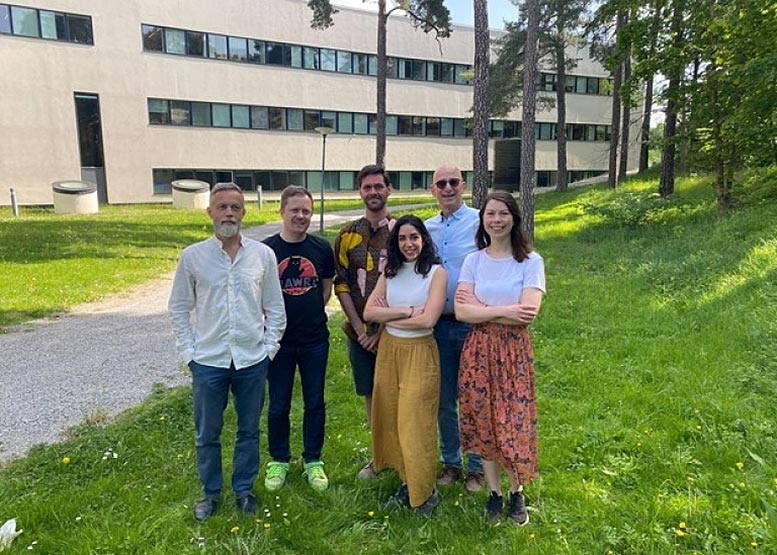
The team at the Oskar Klein Centre, Department of Physics, Stockholm University leading the discovery of SN Zwicky: from the left Edvard Mörtsell, Steve Schulze, Joel Johansson, Ana Sagués Carracedo, Ariel Goobar and Nikki Arendse. Credit: The Oskar Klein Centre
The team’s findings have been published in Nature Astronomy, in a paper titled “Uncovering a population of gravitational lens galaxies with magnified standard candle SN Zwicky”. The publication provides a comprehensive analysis of SN Zwicky, including imaging and spectroscopic data collected from telescopes around the world.
For more on this research, see Supernova Explosion Revealed by Rare “Cosmic Magnifying Glasses.”
Reference: “Uncovering a population of gravitational lens galaxies with magnified standard candle SN Zwicky” by Ariel Goobar, Joel Johansson, Steve Schulze, Nikki Arendse, Ana Sagués Carracedo, Suhail Dhawan, Edvard Mörtsell, Christoffer Fremling, Lin Yan, Daniel Perley, Jesper Sollerman, Rémy Joseph, K-Ryan Hinds, William Meynardie, Igor Andreoni, Eric Bellm, Josh Bloom, Thomas E. Collett, Andrew Drake, Matthew Graham, Mansi Kasliwal, Shri R. Kulkarni, Cameron Lemon, Adam A. Miller, James D. Neill, Jakob Nordin, Justin Pierel, Johan Richard, Reed Riddle, Mickael Rigault, Ben Rusholme, Yashvi Sharma, Robert Stein, Gabrielle Stewart, Alice Townsend, Yozsef Vinko, J. Craig Wheeler and Avery Wold, 12 June 2023, Nature Astronomy.
DOI: 10.1038/s41550-023-01981-3
Institutions including the California Institute of Technology – the leading institution behind the Bright Transient Survey where SN Zwicky was found, University of Cambridge, Liverpool John Moores University, University of Maryland, NASA Goddard Space Flight Center, University of Washington, University of California, Berkeley, University of Portsmouth, Ecole Polytechnique Fédérale de Lausanne, Northwestern University, Humboldt-Universitat zu Berlin, Space Telescope Science Institute, Université de Lyon, CNRS-IN2P3 in France, University of Texas at Austin, and Konkoly Observatory have also contributed to this groundbreaking research.
Researchers at Stockholm University involved in the work are Edvard Mörtsell, Steve Schulze, Joel Johansson, Ana Sagués Carracedo, Ariel Goobar, Nikki Arendse and Remy Joseph from the Department of Physics and Jesper Sollerman from the Department of Astronomy.

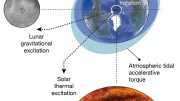
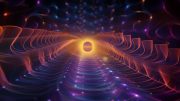

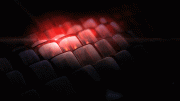
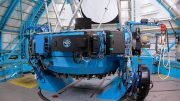
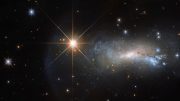


More proof that photons have enough mass to be influenced by individual pulsing lines of radiant gravity force forming expanding spheres of attraction from all objects, from scattering the dots in classic double-slit experiments in earth’s ambient field of gravity to lensing a supernova from behind a large galaxy deep in space; a full-spectrum theory of gravity, intensified by the rotation of objects to appear as “dark matter.”